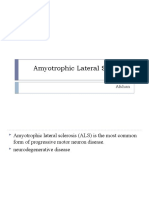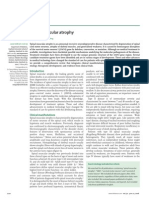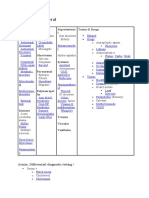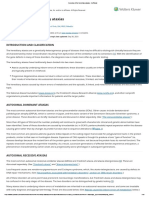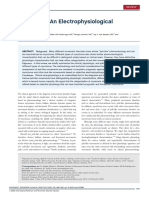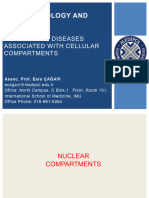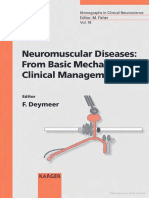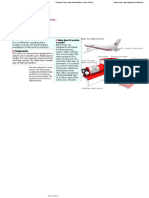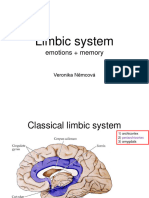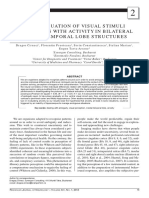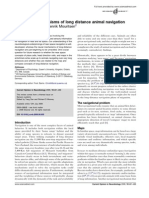Myoclonus With Dementia
Myoclonus With Dementia
Uploaded by
Santosh DashCopyright:
Available Formats
Myoclonus With Dementia
Myoclonus With Dementia
Uploaded by
Santosh DashOriginal Description:
Copyright
Available Formats
Share this document
Did you find this document useful?
Is this content inappropriate?
Copyright:
Available Formats
Myoclonus With Dementia
Myoclonus With Dementia
Uploaded by
Santosh DashCopyright:
Available Formats
Parkinsonism and Related Disorders 9 (2003) 185192
www.elsevier.com/locate/parkreldis
Review
Myoclonus and neurodegenerative diseasewhats in a name?
John N. Caviness*
Department of Neurology, Parkinsons Disease and Movement Disorders Center, Mayo Clinic Scottsdale, 13400 East Shea Blvd, Scottsdale, AZ 85259, USA
Abstract
Myoclonus is a clinical symptom (or sign) defined as sudden, brief, shock-like, involuntary movements caused by muscular contractions or
inhibitions. It may be classified by examination findings, etiology, or physiological characteristics. The main physiological categories for
myocolonus are cortical, cortical subcortical, subcortical, segmental, and peripheral. Neurodegenerative syndromes are potential causes of
symptomatic myoclonus. Such syndromes include multiple system atrophy, corticobasal degeneration, progressive supranuclear palsy,
frontotemporal dementia and parkinsonism linked to chromosome 17, Huntingtons disease, dentato-rubro-pallido-luysian atrophy,
Alzheimers disease, and Parkinsons disease, and other Lewy body disorders. Each neurodegenerative syndrome can have overlapping as
well as distinctive clinical neurophysiological properties. However, claims of differentiating between neurodegenerative disorders by using
the presence or absence of small amplitude distal action myclonus appear unwarranted. When the myoclonus is small and repetitive, it may
not be possible to distinguish it from tremor by phenotypic appearance alone. In this case, clinical neurophysiological offers an opportunity to
provide greater differentiation of the phenomenon. More study of the myoclonus in neurodegenerative disease will lead to a better
understanding of the processes that cause phenotypic variability among these disorders.
q 2003 Elsevier Science Ltd. All rights reserved.
Myoclonus is a clinical symptom (or sign) defined as
sudden, brief, shock-like, involuntary movements caused by
muscular contractions or inhibitions. Myoclonus has now
been recognized to have many possible etiologies, anatomical sources, and pathophysiologic features [1]. When
including all known etiologies, myoclonus has an average
annual incidence of 1.3 cases per 100,000 [2]. The major
categories of myoclonus in the popular etiological classification scheme of Marsden et al. are as follows:
physiologic, essential, epileptic, and symptomatic (secondary) [3] (Table 1). Each of the major categories is associated
with different clinical circumstances. Physiologic myoclonus occurs in neurologically normal people. There is
minimal or no associated disability and the physical exam
reveals no relevant abnormality. Jerks during sleep are the
most familiar examples of physiologic myoclonus. Essential
myoclonus refers to myoclonus that is the most prominent
or only clinical finding. Essential myoclonus is idiopathic
and either there is no or slow progress. Sporadic and
hereditary and sporadic forms exist, and some families
manifest a genetic mutation. Epileptic myoclonus refers to
the presence of myoclonus in the setting of epilepsythat
is, a chronic seizure disorder. Myoclonus can occur as only
one component of a seizure, the only seizure manifestation,
* Tel.: 1-480-301-7989; fax: 1-480-301-8451.
E-mail address: jcaviness@mayo.edu (J.N. Caviness).
or one of multiple seizure types within an epileptic
syndrome. Symptomatic (secondary) myoclonus manifests
in the setting of an identifiable underlying disorder,
neurologic or non-neurologic. Mental status abnormalities
and ataxia are common clinical associations in symptomatic
myoclonic syndromes. Symptomatic causes of myoclonus
comprise a widely diverse group of disease processes and
include neurodegenerative diseases, storage diseases,
toxic metabolic states, physical processes, infections,
focal nervous system damage, and paraneoplastic syndromes as well as other medical illnesses. Most cases of
myoclonus are in the symptomatic category, followed by the
epileptic and essential categories.
1. Physiological classification
Etiological classification provides a framework to match
a patients myoclonus to an etiology from a comprehensive
list of disorders. However, there are at least four advantages
of classifying the myoclonus with regard to its physiology.
First, physiology can provide localizing information for the
myoclonus and thus can provide at least partial localization
for diagnosis of the underlying process. Second, some
physiological myoclonus types are characteristic for certain
disorders, so identifying their presence can aid in
1353-8020/03/$ - see front matter q 2003 Elsevier Science Ltd. All rights reserved.
PII: S 1 3 5 3 - 8 0 2 0 ( 0 2 ) 0 0 0 5 4 - 8
186
J.N. Caviness / Parkinsonism and Related Disorders 9 (2003) 185192
Table 1
Classification of myoclonus
I. Physiologic myoclonus (normal subjects)
A. Sleep jerks (hypnic jerks)
B. Anxiety induced
C. Exercise induced
D. Hiccough (singultus)
E. Benign infantile myoclonus with feeding
II. Essential myoclonus (no known cause and no other gross neurologic deficit)
A. Hereditary (autosomal dominant)
B. Sporadic
III. Epileptic myoclonus (seizures dominate and no encephalopathy, at least initially)
A. Fragments of epilepsy
1. Isolated epileptic myoclonic jerks
2. Epilepsia partialis continua
3. Idiopathic stimulus-sensitive myoclonus
4. Photosensitive myoclonus
5. Myoclonic absences in petit mal epilepsy
B. Childhood myoclonic epilepsy
1. Infantile spasms
2. Myoclonic astatic epilepsy (LennoxGastaut)
3. Cryptogenic myoclonus epilepsy (Aicardi)
4. Awakening myoclonus epilepsy of Janz (Juvenile myoclonic epilepsy)
C. Benign familial myoclonic epilepsy (Rabot)
D. Progressive myoclonus epilepsy: Baltic myoclonus (UnverrichtLundborg)
VI. Symptomatic myoclonus (progressive or static encephalopathy dominates)
A. Storage disease
1. Lafora body disease
2. GM2 gangliosidosis (late infantile, juvenile)
3. Tay-Sachs disease
4. Gauchers disease (non-infantile neuronopathic form)
5. Krabbes leukodystrophy
6. Ceroid-lipofuscinosis (Batten)
7. Sialidosis (cherry-red spot) (types 1 and 2)
B. Spinocerebellar degenerations
1. Ramsay Hunt syndrome
2. Friedreichs ataxia
3. Ataxia telangiectasia
4. Other spinocerebellar degenerations
C. Basal ganglia degenerations
1. Wilsons disease
2. Torsion dystonia
3. HallervordenSpatz disease
4. Progressive supranuclear palsy
5. Huntingtons disease
6. Parkinsons disease
7. Multisystem atrophy
8. Corticobasal degeneration
9. Dentato-rubro-pallido-luysian atrophy
D. Dementias
1. Creutzfeldt Jakob disease
2. Alzheimers disease
3. Lewy body disease
4. Frontotemporal dementia and parkinsonism linked to
chromosome 17
E. Infections/post-infectious
1. Subacute sclerosing panencephalitis
2. Encephalitis lethargica
3. Arborvirus encephalitis
4. Herpes simplex encephalitis
5. HTLV-I
6. Human immunodeficiency virus (HIV)
7. Post-infectious encephalitis
8. Malaria
9. Syphilis
10. Cryptococcus
F. Metabolic
1. Hyperthyroidism
2. Hepatic failure
3. Renal failure
4. Dialysis syndrome
5. Hyponatremia
6. Hypoglycemia
7. Non-ketotic hyperglycemia
8. Multiple carboxylase deficiency
9. Biotin deficiency
10. Mitochondria dysfunction
G. Toxic and drug-induced syndromes
H. Physical encephalopathies
1. Post-hypoxia (Lance-Adams)
2. Post-traumatic
3. Heat stroke
4. Electric shock
5. Decompression injury
I. Focal Nervous System Damage
1. Central Nervous System
(a) Post-stroke
(b) Post-thalamotomy
(c) Tumor
(d) Trauma
(e) Inflammation (e.g. multiple sclerosis)
2. Peripheral nerve lesions
J. Malabsorption
1. Coeliac disease
2. Whipples disease
K. Eosinophilia-Myalgia syndrome
L. Paraneoplastic encephalopathies
M. Opsoclonus-Myoclonus syndrome
1. Idiopathic
2. Paraneoplastic
3. Infectious
4. Other
N. Exaggerated Startle syndromes
1. Hereditary
2. Sporadic
From Marsden et al. [3], with modification.
identifying the underlying diagnoses. Third, ascertaining the
physiology of the myoclonus directs the physician toward
the most effective treatment [1,4]. Finally, comparing and
contrasting the myoclonus physiology in various disorders
provides insights about the disease processes that create
them [4].
The specific methods used in the neurophysiological
study of myoclonus usually include but are not limited to
J.N. Caviness / Parkinsonism and Related Disorders 9 (2003) 185192
187
Fig. 1. Multichannel surface EMG recording in a PD subject during wrist extension demonstrates brief (,50 ms) myoclonus discharges. The arrow denotes the
beginning of a train of myoclonus EMG discharges showing cocontraction between agonist and antagonist (wrist flexors and wrist extensors).
multichannel surface electromyography (EMG) recording
with testing for long latency EMG responses to nerve
stimulation, electroencephalography (EEG), EEG EMG
polygraphy with back-averaging, and evoked potentials
(e.g. median nerve stimulation somatosensory evoked
potential (SEP)). Positive and negative findings from these
methods can then be used to provide evidence for
determining the physiological type of myoclonus. For
example, a back-averaged focal cortical EEG transient,
enlarged cortical SEP, and enhanced long EMG responses
Fig. 2. Back-averaging of myoclonus discharges occurring in right wrist extensors shows a triphasic positivenegative positive focal EEG transient over the
contralateral sensorimotor region. The waveforms were produce by averaging 100 myoclonus EMG discharges similar to those seen in Fig. 1. The EEG
electrode scalp locations are shown on the head figure at the right lower corner. The averaged right wrist extensor EMG is shown at the left lower corner. Time
zero in all waveforms refers to the time at which the trigger mark was placed at the initiation of the myoclonus EMG discharge. For all waveforms, the x-axis is
given in milliseconds and the y-axis is given in microvolts.
188
J.N. Caviness / Parkinsonism and Related Disorders 9 (2003) 185192
are variably seen in cortical origin myoclonus [4]. The
main physiological categories for myoclonus classification
are:
Cortical: most common and has been reported for
various neurodegenerative diseases, toxic metabolic
conditions, post-hypoxic state (Lance Adams syndrome), storage disorders, and other conditions. An
example of cortical myoclonus physiology is shown in
Figs. 1 and 2.
Cortical subcortical: corresponds to the myoclonus in
myoclonic and absence seizures. This physiology is
believed to involve interactions of cortical and subcortical centers such as the thalamus.
Subcortical: seen in essential myoclonus and reticular
reflex myoclonus, among others.
Segmental: arise from segmental brainstem (palatal) and/
or spinal generators.
Peripheral: except for hemifacial spasm, peripheral
myoclonus is rare.
One should be aware that multiple myoclonus physiology types could occur in the same patient.
2. Myoclonus in neurodegenerative disease
2.1. Multiple system atrophy
Two series of multiple system atrophy have reported an
upper extremity small amplitude jerky postural tremor in
20 and 55% of cases, respectively [5,6]. It is believed that
this movement predominantly occurs in the parkinsonian
type of multiple system atrophy. In these same series,
stimulus sensitive myoclonus of the upper extremities was
found in 31 and 16.6% of cases. The literature is split as to
whether this stimulus sensitive myoclonus is more prevalent
in the parkinsonian or cerebellar type of multiple system
atrophy [5,7]. Clearly, the examiners in these case series
made a distinction between the jerky postural tremor and
myoclonus. Salazar et al. [7] argued both on clinical and
electrophysiological grounds that the jerky postural tremor
movements were best characterized as myoclonus rather
than tremor. They found such movements in 9/11 or 82% of
their parkinsonian type multiple system atrophy cases.
Salazar et al. suggested minipolymyoclonus as the term of
choice for this movement.
In the cerebellar presentation of multiple system atrophy,
the electrophysiology of the somatosensory stimulussensitive myoclonus has shown reflex EMG activation
consistent with a trancortical conduction time and enlarged
cortical components of the SEP [8]. Because of these
observations, the myoclonus origin was proposed to be
cortical. In addition, a photic cortical reflex myoclonus has
been described. In these cases, the occipital potentials have
normal amplitude and precede the bilateral frontal potentials
that are time-locked before the generalized myoclonus [9].
In their cases of minipolymyoclonus during postural
activation, Salazar et al. found EMG discharges with less
than 100 ms duration, enhanced long latency EMG
responses to cutaneous stimulation at 50 63 ms, and
normal SEP and EEG. Back-averaging of 50 samples of
the myoclonus demonstrated no back-averaged cortical
correlate. As a result, Salazar et al. [7] were uncertain with
regards to the origin of the myoclonus.
2.2. Corticobasal degeneration and progressive
supranuclear palsy
Myoclonus is an important feature of corticobasal
degeneration and occurs in 50% of cases. Its clinical
presentation parallels that of the overall syndrome with a
focal distribution in the arm (sometimes leg) associated with
other focal limb manifestations that can include apraxia,
rigidity, dystonia, and alien limb phenomenon. A jerky
tremor has been stated to be part of the syndrome, and it has
been noted that the myoclonus is preceded by increased
tremor or jerky tremor [10,11]. The myoclonus in
corticobasal degeneration occurs in repetitive rhythmic
fashion when an attempt is made to activate the arm [12].
Reflex myoclonus to somatosensory stimulation is also very
common.
Multichannel surface EMG recordings in corticobasal
degeneration show rhythmic repetitive trains of 25 50 ms
discharges with simultaneous activation in agonist antagonist pairs. The physiology in corticobasal degeneration
shows a sensitive response to digital nerve stimulation at
about 50 ms. The SEP is either unremarkable or can be
altered in morphology without enlargement. There has been
a cortical correlate back-averaged from magnetoencephalography for this myoclonus, but no back-averaged activity
detected with EEG is characteristic [12]. This myoclonus is
believed to have a cortical origin and may represent a
distinct type of cortical reflex myoclonus [13]. Corticobasal
degeneration is known as a sporadic tau disorder. The tau
pathology has a strong presence in frontoparietal areas and
this could serve as a substrate for the myoclonus generation.
Progressive supranuclear palsy (PSP) is another sporadic
tau disorder, but in contrast to corticobasal degeneration,
myoclonus has only been rarely mentioned in the context of
PSP [14 16]. In one case of autopsy-confirmed PSP, action
myoclonus with seizures showed myoclonus EMG discharges of , 50 ms duration [15]. The myoclonus EMG
discharges grossly correlated with EEG epileptiform
activity, but a time-locked analysis was not done. The
pathology, indicative of PSP, was present in the cerebral
cortex in addition to the more typical subcortical distribution. Palatal myoclonus has also been reported in a case of
PSP [16]. More examples of myoclonus in autopsyconfirmed PSP need to be characterized before any
generalization can be formulated.
J.N. Caviness / Parkinsonism and Related Disorders 9 (2003) 185192
2.3. Frontotemporal dementia and parkinsonism linked to
chromosome 17 (FTDP-17)
Although not initially thought to be a prominent feature,
myoclonus has now been described in some FTDP-17
syndromes. These syndromes, associated with tau gene
mutations, manifest cognitive, psychiatric, and parkinsonian
symptoms. Myoclonus is rarely seen in FTDP-17 kindreds
but has been reported with the N279K, P301S, and V337M
tau mutations, and a different family with the P301S
mutation has been reported to have seizures [17]. We have
described two types of myoclonus physiology in pallidoponto-nigral degeneration (PPND) which has been associated with the N279K tau mutation. The absence of a backaveraged EEG transient characterized the myoclonus
physiology associated with disease progression, whereas a
pre-myoclonus EEG transient was present in the myoclonus
that occurred in one of the individuals with Stage 0 (presymptomatic, gene positive) PPND [17]. FTDP-17 syndromes commonly have cortical and subcortical pathology
[18]. The precise mechanism of the myoclonus types seen
in FTDP-17 syndromes is unclear, but it has been
suggested that pathology in the fronto-parietal area is
more pre-disposed to myoclonus degeneration than frontotemporal pathology [18].
2.4. Huntingtons disease
The occurrence of myoclonus is unusual in Huntingtons
disease, but when present, can be clinically impressive. The
myoclonus is usually restricted to individuals with a young
age of onset and higher CAG repeat mutation values.
Seizures may be present. The physiology of the myoclonus
is consistent with cortical reflex myoclonus, although the
cortical SEP waves are rarely enlarged [19]. Presumably, in
these rapidly progressive young-onset Huntingtons disease
cases, cortical pathology is much more significant when
compared to older cases with lower CAG repeat mutation
values and slower progression, thus enabling the myoclonus
to occur.
2.5. Dentato-rubro-pallido-luysian atrophy (DRPLA)
This neurodegenerative disorder is associated with a
CAG repeat expansion in a gene on chromosome 12.
DRPLA has protean neurologic manifestations that are
variable both within and between families, including
chorea, dystonia, parkinsonism, epilepsy, psychosis, and
dementia [20]. The myoclonus in dentato-rubro-pallidoluysian-atrophy is uncommon, but is usually associated with
epilepsy. A cortical source seems likely for the myoclonus
because of associated epileptiform activity on the EEG, but
detailed electrophysiological examination of the myoclonus
has not been reported [12].
189
2.6. Alzheimers disease
The myoclonus in Alzheimers disease has a varied
presentation profile. It is usually multifocal, although it can
be generalized. The appearance can be sporadic large
myoclonic jerks or repetitive small ones. The occurrence of
the jerks may be at rest, with action, or stimulus induced. It
is common for all the above-mentioned phenotypic
characteristics to occur in a single patient. The prevalence
of myoclonus increases steadily during disease progression,
and up to 50% of Alzheimers disease patients eventually
develop myoclonus. Although myoclonus often develops in
the later stages of the illness, an earlier age of Alzheimers
disease onset, faster progression, or familial causes of
Alzheimers disease are associated with myoclonus appearing earlier and at a higher incidence. In a paper by Wilkins
et al., a few examples of myoclonus in Alzheimers disease
were described as minipolymyoclonus, i.e. small amplitude
repetitive myoclonus occurring distally in the upper
extremities [21]. In the same article, these authors acknowledge the overlap with tremor [21].
Multiple different electrophysiological descriptions of
the myoclonus in Alzheimers disease have been reported.
The most commonly reported instance is myoclonus EMG
discharges , 100 ms duration, and a focal contralateral
central EEG negativity, with onset 20 40 ms pre-myoclonus and duration 40 80 ms [22]. Longer duration and
latencies from EEG transient to the myoclonic jerk, as well
as more widespread EEG transient distributions have been
reported [23]. There can also be periodic sharp waves with
similarity to Creutzfeldt Jacob disease or no EEG correlate
whatsoever. The SEP and long latency EMG reflexes are
variably abnormal.
2.7. Parkinsons disease and other Lewy body disorders
We have described cortical action myoclonus in nondemented Parkinsons disease (PD) individuals, one of which
was pathologically verified as PD [24]. Most cases showed
sporadic small and infrequent myoclonic jerks. However, in
few cases, frequent (. 6 Hz) repetitive rhythmic trains of
EMG discharges coincided with a movement that could
overlap with a tremor phenotype. In our study, multichannel
surface EMG during muscle activation showed multifocal
brief (50 ms) myoclonus EMG discharges in distal upper
extremities (Fig. 1). Back-averaging consistently showed a
focal, short latency, EEG transient prior to the myoclonus
EMG discharge (Fig. 2) [24]. Cortical SEP waves were not
enlarged and long latency EMG responses at rest were not
present. The mechanism of this cortical myoclonus in PD and
other Lewy body disorders has differences from the more
common cortical reflex myoclonus physiology, which is
associated with enlarged cortical SEP waves and enhanced
long latency EMG reflexes. Among our cases, advanced
parkinsonism was not a requirement to manifest this type of
myoclonus [24]. Although these cases were not demented,
190
J.N. Caviness / Parkinsonism and Related Disorders 9 (2003) 185192
we have observed the subsequent development of dementia
in a PD patient who was found to have this cortical
myoclonus 3 years before became manifest. At autopsy,
Lewy bodies were found in the limbic system and neocortex
as well as in the substantia nigra. Thus, it is possible that the
cortical dysfunction that produces myoclonus has an
association with the cortical dysfunction that produces
dementia. In individuals who have dementia with Lewy
bodies (DLB) by consensus criteria, similar myoclonus
properties also occur. However, the myoclonus amplitude in
DLB is clinically more impressive and more common,
occurring in about 15% of cases [25]. In our experience,
patients who experience PD with dementia also demonstrate
the same myoclonus physiology regardless of when the
myoclonus develops. We have also described myoclonus
with similar physiology in a family with hereditary
parkinsonism-dementia with Lewy body pathology [26].
The fact that cortical myoclonus occurs with similar
physiological properties across a spectrum of Lewy body
disorders suggests that a unifying mechanism is responsible
for the myoclonus. It would be of interest to ascertain if the
abnormal basal ganglia output to the cortex via thalamus,
which plays a role in the parkinsonism of voluntary
movements, in some way facilitates cortical myoclonus in
PD. This seems unlikely with the available evidence. Many
of our PD cases demonstrated only a relatively low Hoehn
and Yahr stage of 1.5 2.5 [24]. In other conditions where
parkinsonism and multifocal cortical action myoclonus
coexist such as in DLB and multiple system atrophy, no
correlation with parkinsonism severity has been obvious or
reported. Indeed, a study by Louis et al. [27] found that
myoclonus was much more likely to occur in DLB whereas
a perceived need to treat the patients parkinsonism was
more likely to occur in PD. Although basal ganglia
dysfunction is thought to be pre-eminent in Lewy body
disorder motor symptom pathophysiology, the existence of
cortical myoclonus presents a significant possibility that in
certain cases, cortical pathology may have some influence
on the motor system as well. The neuropathological
examination of our previously reported case showed rare
Lewy bodies in the pre- and post-central gyri as well as
occasional Lewy bodies in the parietal area, cingulate gyrus,
temporal area, and entorhinal cortex [24]. One possible
mechanism for the cortical myoclonus in our cases would be
the lack of inhibitory influences and/or excessive excitation
of sensorimotor cortex produced by the neurodegeneration
occurring locally around the sensorimotor cortical region.
Despite the presence of Alzheimers disease pathology in
Lewy body disorders, it may not contribute to the
mechanism of myoclonus production. As mentioned earlier,
Alzheimers disease patients can develop cortical myoclonus, although sometimes with different electrophysiological
characteristics than what we have described for Lewy body
disorders. However, Dickson [28] has pointed out that
several studies support that Lewy body pathology in PD
brains can become widespread in the cerebrum, but the
Alzheimer-type pathology is not greater than would be
expected for the age of the individual. Marui et al. [29] have
reported that among DLB patients, Lewy body pathology in
the cerebral cortex progresses first in layers V-VI,
subsequently in layer III and finally in layer II. Although
the cerebral pathology first progresses in the amygdala, it is
known to subsequently spread to the limbic cortex and
finally in the neocortex [29]. Such pathology, if it reaches
motor areas of the neocortex, could be responsible for
cortical myoclonus generation. However, with these diffuse
changes, neurochemical abnormalities and/or abnormal
remote input from other areas (cortical and/or subcortical)
possibly may be playing a significant role.
3. Small amplitude repetitive movements in
neurodegenerative disordersmyoclonus versus tremor
When the myoclonus is moderately large and has obvious
irregular timing, the phenomenology is clear. This is typical
in Creutzfeldt Jakob disease, post-hypoxic myoclonus,
progressive myoclonus epilepsy, toxic metabolic conditions, and in many other disorders, including some cases
of Alzheimers disease and DLB. Stimulus sensitive
myoclonus is usually easily discerned. However, when the
myoclonus is small and action induced, it is only a minor
determinant of disability at most and may be difficult or
impossible to differentiate from tremor. Besides the
examples mentioned above concerning neurodegenerative
disease, other investigators have examined rhythmic
phenomena in myoclonus. Peter Brown and others [30,31]
have recently emphasized physiological evidence of rhythmic EEG and EMG discharges with significant EEG EMG
coherence. The term, cortical tremor was first coined by
Ikeda et al. [32]. The movement in their patients was
described as shivering-like tremor and fine shivering-like
twitchings. In that paper, the tremor discharges were found
to have classic characteristics of cortical reflex myoclonus,
including the finding of a back-averaged cortical spike
discharge. Other articles about cortical tremor have since
been published, including Toro et al. who asserted that such a
phenomenon was a common manifestation of cortical
myoclonus [33 35]. The consensus statement of the Movement Disorder Society on tremor implies that the term,
cortical tremor, is misleading. The statement comments that
cortical tremor is not a tremor but a specific form of rhythmic
myoclonus consisting of (1) high-frequency, irregular
tremor-like postural and kinetic myoclonus almost indistinguishable from high-frequency postural tremor and (2)
synchronous, short, high-frequency jerks (7 18 Hz) on
EMG [36].
Chronic progression and insidious onset characterize
neurodegenerative diseases. In such cases that produce
hyperkinetic movement disorders, the abnormal physiology
of movement control gradually evolves over time. Before
the repetitive action myoclonus of neurodegenerative
J.N. Caviness / Parkinsonism and Related Disorders 9 (2003) 185192
disease is easily identified as myoclonus, it would be
conceivable that the abnormal physiology may pass through
a stage when the EMG discharges produce a movement
elicited by action that appears as a small amplitude tremor.
This has already been alluded to in the instance of
corticobasal degeneration as mentioned earlier. Before,
during, and after the transition between tremor and
myoclonus, the discharges themselves and their associated
physiology may be different. The abnormal physiology may
never progress to reveal a clear distinctive phenomenology
between tremor and myoclonus. Thus, it is unrealistic to
suggest that there are definitive criteria to decide where
regularity stops and irregularity begins or that the dividing
line between myoclonus and tremor is always clear.
Furthermore, the consensus statement terms, tremor-like,
and almost indistinguishable lack precision. It may be
most prudent to accept the inexact nature of phenomenology
and the inability of a clinical exam to discern tremor from
myoclonus in all of these cases. Indeed, reasonable
persons (even experts) will disagree on whether a certain
example of repetitive brief movements is tremor, myoclonus, or something else. Description of electrophysiologic
features, as the consensus statement on tremor points out,
should be performed to allow greater specificity on the
classification of signs and symptoms [36]. However,
especially in neurodegenerative disease, phenomenological
boundaries will continue to be debated.
4. Summary: myoclonus in neurodegenerative disease
and its significance
Most myoclonus in neurodegenerative disease is classified as cortical. This is easy to accept in disorders such as
Alzheimers disease and corticobasal degeneration, in which
the cortical pathology is fairly consistent and well known. In
PD, most noted for its subcortical pathology, the finding of
small amplitude myoclonus with an EEG correlate on
clinical neurophysiology testing documents cortical dysfunction and probably primary cortical pathology. In our
experience, this can sometimes herald the onset of dementia
in PD. Thus, in this instance, even if the cortical myoclonus is
small, it may have important meaning. Cortical myoclonus
can respond to treatment, but the disability from small
amplitude myoclonus may not justify treatment side effects
[1]. An important exception to the cortical origin of
myoclonus in neurodegenerative disease may be multiple
system atrophy, where the source of the small amplitude
distal action myoclonus is unknown [7]. It is also important to
realize that even when a myoclonus cortical correlate is
present, subcortical influences may still exist. Nevertheless,
small amplitude distal action myoclonus seems to be a
possible manifestation of many different neurodegenerative
disorders and maybe more common in individual disorders
than what is generally appreciated. Thus, claims of
differentiating between neurodegenerative disorders by
191
using the presence or absence of small amplitude distal
action myoclonus appear unwarranted. The use of clinical
neurophysiology helps in defining the nature of the EMG
discharges in such disorders, but the current ability of these
electrophysiology techniques to provide desired specificity is
lacking. However, this situation should improve with further
study of myoclonus physiology in the various neurodegenerative disorders. Finally, determining with certainty
whether a given repetitive high frequency small amplitude
distal movement should be named myoclonus or tremor may
be not possible in some cases and may be arbitrary. This
should not discourage the study of such movements. Rather,
it should make us wonder more about why they come to exist
in the various neurodegenerative disorders.
References
[1] Cavinesss JN. Myoclonus: a clinical review. Mayo Clinic Proc 1996;
71:67988.
[2] Caviness JN, Alving LI, Maraganore DM, Black R, McDonnell SK,
Rocca WA. The incidence and prevalence of Myoclonus in Olmsted
County. Mayo Clinic Proc 1999;74:565 9.
[3] Marsden CD, Hallett M, Fahn S. The nosology and pathophysiology
of myoclonus. In: Marsden CD, Fahn S, editors. Movement disorders.
London: Butterworths; 1982. p. 196248.
[4] Shibasaki H. Electrophysiological studies of myoclonus. AAEM
Minimonograph #30. Muscle Nerve 2000;23:32135.
[5] Wenning GK, Ben Shlomo Y, Magalhaes M, Daniel SE, Quinn NP.
Clinical features and natural history of multiple system atrophy. Brain
1994;117:835 45.
[6] Gouider-Khouja N, Vidaihet M, Bonnet A-M, Pichon J, Agid Y. Pure
striatonigral degeneration and Parkinsons disease: a comparative
clinical study. Mov Disord 1995;10:28894.
[7] Salazar G, Valls-Sole J, Marti MJ, Chang H, Tolosa ES. Postural and
action myoclonus in patients with Parkinsonian type multiple system
atrophy. Mov Disord 2000;15:7783.
[8] Rodriguez ME, Artieda J, Zubieta JL, Obeso JA. Reflex myoclonus in
olivopontocerebellar atrophy. J Neurol Neurosurg Psychiatry 1994;
57:3169.
[9] Artieda J, Obeso JA. The pathophysiology and pharmacology of
photic cortical reflex myoclonus. Ann Neurol 1993;34:17584.
[10] Brunt ERP, van Weerden TW, Pruim J, Lakke WPFJ. Unique
Myoclonic pattern in corticobasal degeneration. Mov Disord 1995;10:
13242.
[11] Lang AE, Riley DE, Bergeron C. Cortical-basal ganglionic degeneration. In: Calne DB, editor. Neurodegenerative diseases. Philadelphia:
WB Saunders; 1994. p. 87794.
[12] Thompson PD, Shibasaki H. Myoclonus in corticobasal degeneration
and other neurodegenerations. In: Litvan I, Goetz CG, Lang AE,
editors. Corticobasal degeneration, advances in neurology, vol. 82.
Philadelphia: Lippincott/Williams & Wilkins; 2000. p. 69 81.
[13] Thompson PD, Day BL, Rothwell JC, Brown P, Britton TC, Marsden
CD. The myoclonus in corticobasal degeneration. Brain 1994;117:
1197 207.
[14] Litvan I, Agid Y, Calne D, Campbell G, Dubois B, Duvoisin RC,
Goetz CG, Golve LI, Grafman J, Growdon JH, Hallett M, Jankovic J,
Quinn NP, Tolosa E, Zee DS. Clinical research criteria for the
diagnosis of progressive supranuclear palsy (SteeleRichardson
Olszewski syndrome): report of the NINDS-SPSP international
workshop. Neurology 1996;47:19.
[15] Kurihara T, Landau WM, Torack RM. Progressive supranuclear palsy
with action myoclonus, seizures. Neurology 1974;24:21923.
192
J.N. Caviness / Parkinsonism and Related Disorders 9 (2003) 185192
[16] Suyama N, Kobayashi S, Isino H, Iijima M, Imaoka K. Progressive
supranuclear palsy with palatal myoclonus. Acta Neuropathol 1997;
94:2903.
[17] Caviness JN, Wzsolek ZK. Myoclonus in ponto-pallidal-nigraldegeneration (PPND). In: Fahn S, Frucht SJ, Hallett M, Truong DD,
editors. Myoclonus and paroxysmal dyskinesias. Advances in
Neurology, vol. 89. New York, NY: Lippincott/Williams & Wilkins;
2002. p. 359.
[18] Bugiani O, Murrell JR, Giaccone G, Hasegawa M, Ghigo G, Tabaton
M, et al. Frontotemporal dementia and corticobasal degeneration in a
family with a P301S mutation in tau. J Neuropathol Exp Neurol 1999;
58(6):667 77.
[19] Caviness JN, Kurth M. Cortical myoclonus in Huntingtons disease
associated with an enlarged somatosensory evoked potential. Mov
Disord 1997;12(6):1046 51.
[20] Warner TT, Williams LD, Walker WH, Flinter F, Robb SA, Bundey
SE, Honavar M, Harding AE. A clinical and molecular genetic study
of dentatorubropallidoluysian atrophy in four european families. Ann
Neurol 1995;37:452 9.
[21] Wilkins DE, Hallett M, Erba G. Primary generalised epileptic
myoclonus: a frequent manifestation of minipolymyoclonus of
cortical origin. J Neurol Neurosurg Psychiatry 1985;48:50616.
[22] Wilkins DE, Hallett M, Berardelli A, Walshe T, Alvarez N.
Physiologic analysis of the myoclonus of Alzheimers disease.
Neurology 1984;34:898903.
[23] Ugawa Y, Kohara N, Hirasawa H, Kuzuhara S, Iwata M, Mannen T.
Myoclonus in Alzheimers disease. J Neurol 1987;235:904.
[24] Caviness JN, Adler CH, Newman S, Caselli RJ, Muenter MD. Cortical
myoclonus in Levodopa-responsive parkinsonism. Mov Disord 1998;
13:5404.
[25] Burkhardt CR, Filley CM, Kleinschmidt-DeMasters BK, de la Monte
S, Norenberg MD, Schneck SA. Diffuse Lewy body disease and
progressive dementia. Neurology 1988;38:15208.
[26] Caviness JN, Gwinn-Hardy KA, Adler CH, Muenter MD. Electrophysiological observations in hereditary parkinsonism-dementia with
Lewy body pathology. Mov Disord 2000;15:140 5.
[27] Louis ED, Klatka LA, Liu Y, Fahn S. Comparison of extrapyramidal
features in 31 pathologically confirmed cases of diffuse Lewy body
disease and 34 pathologically confirmed cases of Parkinsons disease.
Neurology 1997;48:37680.
[28] Dickson DW. Alpha-synuclein and the Lewy body disorders. Curr
Opin Neurol 2001;14:423 32.
[29] Marui W, Iseki E, Nakai T, Miura S, Kato M, Ueda K, Kosaka K.
Progression and staging of Lewy pathology in brains from patients
with dementia with Lewy bodies. J Neurol Sci 2002;195:153 9.
[30] Brown P, Marsden CD. Rhythmic cortical and muscle discharge in
cortical myoclonus. Brain 1996;119:130716.
[31] Brown P, Farmer SF, Halliday DM, Marsden J, Rosenberg JR.
Coherent cortical and muscle discharge in cortical myoclonus. Brain
1999;122:46172.
[32] Ikeda A, Kakigi R, Funai N, Neshige R, Kuroda Y, Shibasaki H.
Cortical tremor: a variant of cortical reflex myoclonus. Neurology
1990;40:15615.
[33] Toro C, Pascul-Leone A, Deuschl G, Tate E, Pranzatelli MR, Hallett
M. Cortical tremora common manifestation of cortical myoclonus.
Neurology 1993;43:234653.
[34] Oguni E, Hayashi A, Ishii A, Mizusawa H, Shoji S. A case of cortical
tremor as a variant of cortical reflex myoclonus. Eur Neurol 1995;35:
63 4.
[35] Terada K, Ikeda A, Mima T, Kimura K, Nagahama Y, Kamioka Y,
Murone I, Kimura J, Shibasaki H. Familial cortical myoclonic tremor
as a unique form of cortical reflex myoclonus. Mov Disord 1997;12:
370 7.
[36] Deuschl G, Bain P, Brin M, et al. Consensus statement of the
movement disorder society on tremor. Mov Disord 1998;13:223.
You might also like
- Neurology Multiple Choice Questions With Explanations: Volume IFrom EverandNeurology Multiple Choice Questions With Explanations: Volume IRating: 4 out of 5 stars4/5 (8)
- Amyotrophic Lateral SclerosisDocument23 pagesAmyotrophic Lateral SclerosisAfshan Pt T100% (1)
- Kejang MioklonikDocument26 pagesKejang MioklonikDhamara AdhityaNo ratings yet
- Pathophysiology and Treatment of MyoclonusDocument21 pagesPathophysiology and Treatment of MyoclonusVincentius Michael WilliantoNo ratings yet
- Myoclonic DisordersDocument20 pagesMyoclonic DisordersStacey WoodsNo ratings yet
- Amyotrophic Lateral SclerosisDocument11 pagesAmyotrophic Lateral SclerosisAnomalie12345No ratings yet
- VEM5384 Clincial Neurology DisordersDocument62 pagesVEM5384 Clincial Neurology DisordersdeadnarwhalNo ratings yet
- Em - Revision Del Lancet-1Document16 pagesEm - Revision Del Lancet-1César Vásquez AguilarNo ratings yet
- Seminar: Mitchell R Lunn, Ching H WangDocument14 pagesSeminar: Mitchell R Lunn, Ching H WangCatalina AlzogarayNo ratings yet
- B5W1L9.Peripheral Neuropathy - Lecture Notes 12Document4 pagesB5W1L9.Peripheral Neuropathy - Lecture Notes 12mihalcea alinNo ratings yet
- ATROFIA MUSCULAR ESPINAL Lancet 2008Document14 pagesATROFIA MUSCULAR ESPINAL Lancet 2008Sebastián Silva SotoNo ratings yet
- Clinical and Genetic Basis of Familial Amyotrophic Lateral Sclerosis (Revisión)Document12 pagesClinical and Genetic Basis of Familial Amyotrophic Lateral Sclerosis (Revisión)Francisco Ahumada MéndezNo ratings yet
- ATAXIAS PTDocument13 pagesATAXIAS PTKarunya VkNo ratings yet
- Dancing Eyes-Dancing Feet' DiseaseDocument16 pagesDancing Eyes-Dancing Feet' DiseaseLew NianNo ratings yet
- Idiopathic ScoliosisDocument12 pagesIdiopathic ScoliosisAlessandro BergantinNo ratings yet
- Genetic and Unknown Factors in The EtiolDocument8 pagesGenetic and Unknown Factors in The EtiolMariana BaltarNo ratings yet
- Foguem 17837Document8 pagesFoguem 17837Carolina RibeiroNo ratings yet
- Leukodystrophy Paper August 27thDocument7 pagesLeukodystrophy Paper August 27thZorbey TurkalpNo ratings yet
- 10 - Prinicples of Lesion LocalizingDocument12 pages10 - Prinicples of Lesion LocalizingHo Yong WaiNo ratings yet
- 10.1007@s10072 020 04495 2Document7 pages10.1007@s10072 020 04495 2Julio Alberto VásquezNo ratings yet
- Multiple Sclerosis - The Disease and Its ManifestationsDocument8 pagesMultiple Sclerosis - The Disease and Its ManifestationsCecilia FRNo ratings yet
- Convulsion Febril PediatricsDocument11 pagesConvulsion Febril PediatricsOrlando HernandezNo ratings yet
- Epilepsy: Head TraumaDocument17 pagesEpilepsy: Head TraumaAimanRiddleNo ratings yet
- Neurodegener RalucaDocument88 pagesNeurodegener RalucaAlexandra AnaellyNo ratings yet
- Management of Spasticity and Cerebral Palsy: Yasser Awaad, Tamer Rizk and Emira ŠvrakaDocument26 pagesManagement of Spasticity and Cerebral Palsy: Yasser Awaad, Tamer Rizk and Emira ŠvrakaAgnimitra ChoudhuryNo ratings yet
- Ann MS Id 000849Document8 pagesAnn MS Id 000849azucenadeoNo ratings yet
- Clinical Cases in Pediatric Peripheral NeuropathyDocument23 pagesClinical Cases in Pediatric Peripheral NeuropathyMateen ShukriNo ratings yet
- Guillain - Barre Syndrome (Adams)Document10 pagesGuillain - Barre Syndrome (Adams)Phone ApplicationNo ratings yet
- Amyotrophic Lateral SclerosisDocument9 pagesAmyotrophic Lateral SclerosisCaroline ItnerNo ratings yet
- Overview of The Hereditary Ataxias - UpToDateDocument15 pagesOverview of The Hereditary Ataxias - UpToDatericanoy191No ratings yet
- Fasciculations What Do We Know of Their SignificanceDocument6 pagesFasciculations What Do We Know of Their SignificanceShauki AliNo ratings yet
- Toxoplasmosis y NeosporaDocument12 pagesToxoplasmosis y NeosporaAntonio ReaNo ratings yet
- Clinical and Neuropathological Criteria For Frontotemporal DementiaDocument3 pagesClinical and Neuropathological Criteria For Frontotemporal DementiaSandra MilenaNo ratings yet
- Myoclonus: An Electrophysiological Diagnosis: Clinical PracticeDocument11 pagesMyoclonus: An Electrophysiological Diagnosis: Clinical PracticeTalib AdilNo ratings yet
- Journal of AMCDocument6 pagesJournal of AMCMarko SimonceliNo ratings yet
- Review Article: Diagnosing Arthrogryposis Multiplex Congenita: A ReviewDocument7 pagesReview Article: Diagnosing Arthrogryposis Multiplex Congenita: A ReviewnuriajunitNo ratings yet
- MR Findings in Leigh Syndrome With COX Deficiency and SURF-1 MutationsDocument6 pagesMR Findings in Leigh Syndrome With COX Deficiency and SURF-1 MutationsDrsandy SandyNo ratings yet
- Comment Letters: Similarity of Balloon Cells in Focal Cortical Dysplasia To Giant Cells in Tuberous SclerosisDocument4 pagesComment Letters: Similarity of Balloon Cells in Focal Cortical Dysplasia To Giant Cells in Tuberous SclerosisashfaqamarNo ratings yet
- What Is NeurodegenerationDocument8 pagesWhat Is NeurodegenerationJuan Castaño CastroNo ratings yet
- Spinal Cord Diseases Overview in Dogs (Canis) VetlexiconDocument9 pagesSpinal Cord Diseases Overview in Dogs (Canis) Vetlexicont.dambazaNo ratings yet
- Marinesco-Sjo Gren Syndrome - 2013Document5 pagesMarinesco-Sjo Gren Syndrome - 2013Irfan RazaNo ratings yet
- Epilepsy Principles and DiagnosisDocument26 pagesEpilepsy Principles and DiagnosisLauriettaNo ratings yet
- Amyotrophic Lateral SclerosisDocument15 pagesAmyotrophic Lateral SclerosisYakan AbdulrahmanNo ratings yet
- 2021.01 MBG Diseases Associated With Cellular CompartmentsDocument38 pages2021.01 MBG Diseases Associated With Cellular CompartmentskenbasinioNo ratings yet
- Sleep Hypoventilation in Neuromuscular and Chest Wall DisordersDocument15 pagesSleep Hypoventilation in Neuromuscular and Chest Wall Disorderssavvy_as_98-1No ratings yet
- Ref Ref 2Document5 pagesRef Ref 2melly adityaNo ratings yet
- Muscular DystoniaDocument20 pagesMuscular Dystoniarudresh singhNo ratings yet
- Neuromuscular Diseases PDFDocument205 pagesNeuromuscular Diseases PDFsalmazzNo ratings yet
- Multiple SclerosisDocument9 pagesMultiple SclerosisFrancis RomanosNo ratings yet
- Finding (Neurology)Document12 pagesFinding (Neurology)Ayu NoviantiNo ratings yet
- Electrodiagnosis in MyopathiesDocument15 pagesElectrodiagnosis in MyopathiesJulian DavidNo ratings yet
- Degenerative Diseases of The Nervous SystemDocument87 pagesDegenerative Diseases of The Nervous SystemNancy MosesNo ratings yet
- Mekanisme Gangguan Neurologi Pada EpilepsiDocument6 pagesMekanisme Gangguan Neurologi Pada EpilepsiIndah Indryani UNo ratings yet
- 03 Sarah OConnorDocument3 pages03 Sarah OConnorMateen ShukriNo ratings yet
- Enfermedades LisosomalesDocument32 pagesEnfermedades LisosomalesJonathanOmarLaraAcevedo100% (1)
- JMD 4 1 21 4Document12 pagesJMD 4 1 21 4Allan Salmeron MendozaNo ratings yet
- What Is Lennox-Gastaut Syndrome in The Modern Era?: Hirokazu OguniDocument2 pagesWhat Is Lennox-Gastaut Syndrome in The Modern Era?: Hirokazu OguniWinsen HaryonoNo ratings yet
- Metabolik EncelophatyDocument8 pagesMetabolik EncelophatyfkiaNo ratings yet
- Absence Seizures: From Pathophysiology to Personalized CareFrom EverandAbsence Seizures: From Pathophysiology to Personalized CareNo ratings yet
- Fibromyalgia SyndromeFrom EverandFibromyalgia SyndromeJacob N. AblinNo ratings yet
- Quian Quiroga, 2005 PDFDocument6 pagesQuian Quiroga, 2005 PDFMarilia BaquerizoNo ratings yet
- Sci & Tech (Till Jan 2016)Document270 pagesSci & Tech (Till Jan 2016)Diptendu DasNo ratings yet
- Alekls 1202Document113 pagesAlekls 1202Joseph SikatumbaNo ratings yet
- Dragos Cirneci Ambiguitate Anxietate 2013Document9 pagesDragos Cirneci Ambiguitate Anxietate 2013dgavrileNo ratings yet
- Limbic Sys - ArchDocument85 pagesLimbic Sys - Archdrkadiyala2No ratings yet
- 3917 FullDocument15 pages3917 FullWesleyNo ratings yet
- Juxtacortical Lesions and Cortical Thinning in Multiple SclerosisDocument7 pagesJuxtacortical Lesions and Cortical Thinning in Multiple SclerosishelenNo ratings yet
- James A Bourgeois & Usha Parthasarathi PDFDocument626 pagesJames A Bourgeois & Usha Parthasarathi PDFalex_santillan_26No ratings yet
- Limbic System NeuroscienceDocument82 pagesLimbic System Neuroscience250187155No ratings yet
- The Claustrum Coordinates Cortical Slow-Wave Activity: ArticlesDocument27 pagesThe Claustrum Coordinates Cortical Slow-Wave Activity: ArticlescutkilerNo ratings yet
- Paraphilias As A Sub Type of Obsessive-Compulsive Disorder: A Hypothetical Bio-Social ModelDocument14 pagesParaphilias As A Sub Type of Obsessive-Compulsive Disorder: A Hypothetical Bio-Social ModelmuiNo ratings yet
- DM Neurology ThesisDocument7 pagesDM Neurology ThesisFindSomeoneToWriteMyPaperLowell100% (2)
- Cummings Neuropsychiatry PDFDocument1,162 pagesCummings Neuropsychiatry PDFaanchal75% (4)
- NeocortexDocument1 pageNeocortexZeromalisNilNo ratings yet
- Lisman 2005 ADocument10 pagesLisman 2005 AnavinavinaviNo ratings yet
- Patzke 2013Document23 pagesPatzke 2013Kamilla souzaNo ratings yet
- Mnemonic Similarity Task: A Tool For Assessing Hippocampal IntegrityDocument14 pagesMnemonic Similarity Task: A Tool For Assessing Hippocampal IntegrityEszter SzerencsiNo ratings yet
- Interactions Between Rodent Visual and Spatial Systems During NavigationDocument15 pagesInteractions Between Rodent Visual and Spatial Systems During Navigation伟健宗No ratings yet
- The Neural Mechanisms of Long Distance Animal Navigation: Barrie J Frost and Henrik MouritsenDocument8 pagesThe Neural Mechanisms of Long Distance Animal Navigation: Barrie J Frost and Henrik MouritsenGaurava SrivastavaNo ratings yet
- The Cingulate Cortex and Limbic Systems For Emotion, ActionDocument18 pagesThe Cingulate Cortex and Limbic Systems For Emotion, ActionlialiaNo ratings yet
- Spatial Perception and ArchitectureDocument11 pagesSpatial Perception and ArchitectureVinayAgrawal100% (1)
- Squire Zola 1996Document8 pagesSquire Zola 1996cecilia martinezNo ratings yet
- Quian Quiroga - Invariant Visual Representation by Single Neurons in The Human BrainDocument6 pagesQuian Quiroga - Invariant Visual Representation by Single Neurons in The Human BraintemppoNo ratings yet
- 7 - M. Ullman 2016 - Modelo DPDocument16 pages7 - M. Ullman 2016 - Modelo DPruiNo ratings yet
- Neurofisiologia Stratton DonaldDocument33 pagesNeurofisiologia Stratton Donaldfelipe ospino100% (1)
- Assessing Hippocampal Functional Reserve in Temporal Lobe Epilepsy: A Multi-Voxel Pattern Analysis of Fmri DataDocument10 pagesAssessing Hippocampal Functional Reserve in Temporal Lobe Epilepsy: A Multi-Voxel Pattern Analysis of Fmri DataMilena RamirezNo ratings yet
- The Brain S Social Road MapsDocument6 pagesThe Brain S Social Road MapsKarla ValderramaNo ratings yet
- Papez CircuitDocument14 pagesPapez CircuitDeeptiNo ratings yet
- 3 ArticleDocument59 pages3 ArticleAlbert PierssonNo ratings yet
- Neuroview: The 2014 Nobel Prize in Physiology or Medicine: A Spatial Model For Cognitive NeuroscienceDocument6 pagesNeuroview: The 2014 Nobel Prize in Physiology or Medicine: A Spatial Model For Cognitive NeuroscienceVictor CarrenoNo ratings yet

